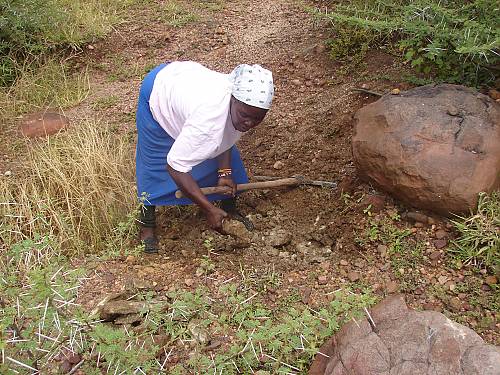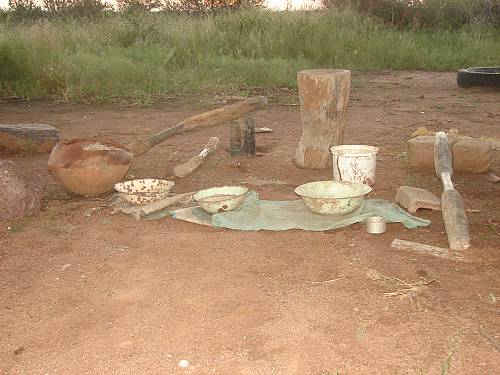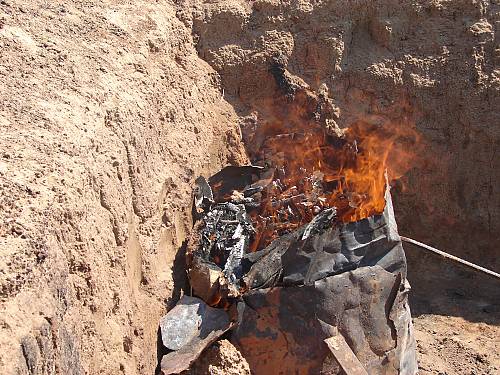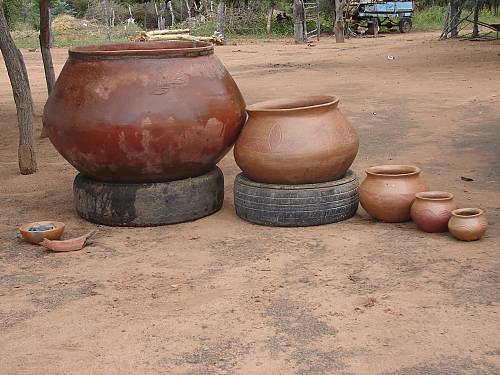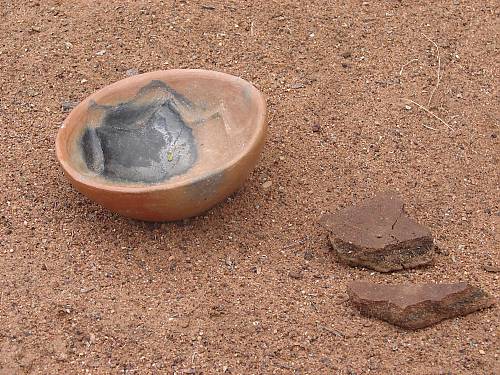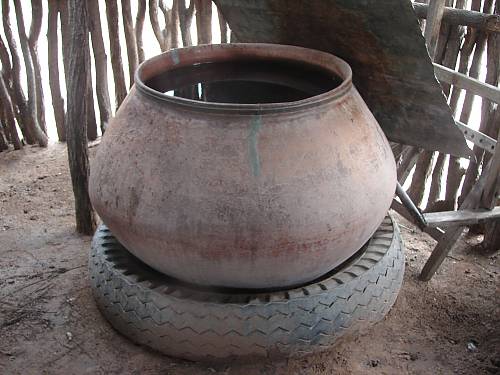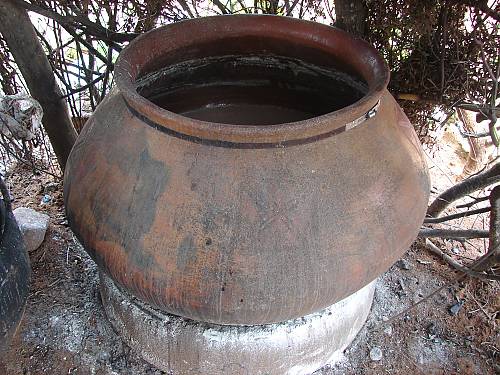Report on the status of an element inscribed on the list of intangible cultural heritage in need of urgent safeguarding
A. Cover sheet
A.1.
State Party
Name of State Party
Botswana
A.2.
Date of deposit of the instrument of ratification, acceptance, approval or accession
This information is available online.
Date of deposit of the instrument of ratification, acceptance, approval or accession
2010-04-01
A.3.
Element inscribed on the Urgent Safeguarding List that is the subject of this report
Name of element
Earthenware pottery-making skills in Botswana’s Kgatleng District
Inscribed in
2012
A.4.
Reporting period covered by this report
Please indicate the period covered by this report.
Reporting period covered by this report
01-12-2012 - 01-12-2016
A.5.
Other elements inscribed on the Urgent Safeguarding List, if any
Please list all other elements from your country inscribed on the Urgent Safeguarding List, together with the year of inscription; for multinational elements, please indicate the other States concerned.
Other elements inscribed on the Urgent Safeguarding List, if any
Dikopelo folk music of Bakgatla ba Kgafela in Kgatleng District (2017)
Seperu folkdance and associated practices (2019)
A.6.
Executive summary of the report
Please provide an executive summary of the report that will allow general readers to understand the current status of the element, any positive or negative impacts of inscription, the implementation of safeguarding measures during the reporting period and their possible update for the following years.
Executive summary of the report
Earthenware Pottery Making Skills is an intangible cultural heritage element practiced among the Bakgatla ba Kgafela in the South Eastern parts of Botswana. Practitioners of the element make pots of different sizes and decorative patterns that are related to the cultural practices and beliefs of the Bakgatla ba Kgafela community. There are six earthenware pots which are classified according to their uses. However, only two types of earthenware pots are in high demand. The smallest pot referred to as nkgwana ya sedimo (ancestral pot) is currently being used for spiritual purposes by religious leaders and their followers for ritual purposes. The biggest pot, referred to a setsaga (beer pot) is also in high demand especially for cultural ceremonies such as weddings an other celebratory ceremonies. The use of the setsaga has also been diversified as it is now bein sed to store water, replacing nkgo ya metsi or water storage pot.
The inscription of the element has helped in the visibility and promotion of the element as more people have started recognizing its importance. This has created economic opportunities for the practitioners of the element who are being commissioned and continue to showcase their works in different exhibitions. As a result, two apprentices of the element have now graduated to a status of Master Potter and are carrying out pottery business away from their mentors. The Master Potters have been involved in different transmission efforts for both students and out of school trainees. The girls initiation school (Bojale) of the Bakgatla ba Kgafela has also been used as an avenue to transmit the earthenware pottery making skills to initiates. About ninety - five (95) initiates have been introduced to the element during Bojale by one practitioner who was discovered during the initiation. A cultural space associated with the tangible elements has been discovered by the Master Potters in the Oodi Cluster of Kgatleng District and negotiations are underway with relevant stakeholders to ensure the protection of the site and viability of the element.
Phuthadikobo Museum, as the competent body, has been at the forefront in ensuring the implementation of the Safeguarding Plan. The Community Museum played a huge role in the formation of Badirangwao Visual Arts Association, which is meant to look at the interests of earthenware potters. One Master Potter is currently the Secretary of the organization and plans are underway to attract other potters to the Association. The Museum continues to sensitize different stakeholders about the element and intangible cultural heritage in general and has recently received funding from the Intangible Cultural Heritage Fund to implement the initial Safeguarding Plan. The Ministry of Youth Empowerment, Sport and Culture Development continues to promote the element and has provided funding as well as publishing a booklet on the element.
Transmission of the element remains problematic as the youth who were introduced to the element during initiation school have not shown eagerness to engage in the practice. Elderly women who have been trained on the practicing of the element have also abandoned it citing turnaround time and strict taboos. lt is for this reason that the updated Safeguarding Plan will focus on the transmission of the element among the young people. lt will also deal with research and documentation of the promotion of the value and status of rituals associated with earthenware making. The new safeguarding plan will also facilitate attachment of young practitioners with pottery industries for sustainable development purposes. While Phuthadikobo Museum will remain the competent body, Badirangwao Visual Arts Association will be activated to play a major role in the safeguarding of the element.
A.7.
Contact person for correspondence
Provide the name, address and other contact information of the person responsible for correspondence concerning the report.
Title (Ms/Mr, etc.)
Ms
Family name
Phuti
Given name
Dineo
Institution/position
Policy Specialist
Address
Ministry of Youth Empowerment, Sport and Culture Development
Private Bag 00514
Gaborone
Telephone number
+267 393 3387; +267 71392104
E-mail address
dphuti@gov.bw
Other relevant information
B
Ms
B. Status of element inscribed on the Urgent Safeguarding List
Refer to the nomination file or to previous reports, if any, as the basis for reporting on the current status of the element, and report only on relevant changes since the date of inscription on the List or since the previous report. Nomination files, specific timetables and earlier reports, if any, are available at https://ich.unesco.org or from the Secretariat, upon request.
The State Party shall pay special attention to the role of gender and shall endeavour to ensure the widest possible participation of the communities, groups and, where applicable, individuals concerned as well as relevant non-governmental organizations during the process of preparing this report, and is asked to describe how it has done so in point D below.
B.1.
Social and cultural functions
Please explain the social and cultural functions and meanings of the element today, within and for its community, the characteristics of the bearers and practitioners, and any specific roles or categories of persons with special responsibilities towards the element, among others. Attention should be given to any relevant changes related to inscription criterion U.1 (‘the element constitutes intangible cultural heritage as defined in Article 2 of the Convention’).
Social and cultural functions
Earthenware Pottery Making Skills in Botswana's Kgatleng District is practised among the Bakgatla ba Kgafela community to make pots of different designs that relate to the traditional practices and beliefs of the community. Pots are used for storing traditional beer, fermenting sorghum meal, fetching and storing water, cooking Bakgatla staple food, ancestral worship and traditional healing rituals. The pots form part and parcel of the arts and craft exhibition during Sedibelo Heritage Festival, which is a community festival celebrating the cultural heritage of Bakgatla ba Kgafela and are also used during the ploughing season as storage for seeds. When collecting the tangible resources of the element such as soils, the Master Potter communicates with the ancestors through meditation so that she will be guided to the ideal spot. lt is believed that the soil resources belong to the ancestors and therefore, there are some sacred rituals performed when collecting them. There are prescribed regulations and certain precautions to be observed, if not the practitioners may not be able to collect the soil resources. Anyone can assist in the process of pottery making as individuals like men, young boys and girls or children. The men would usually help to dig and pound the soil but the Master Potter is the one who collects the soil and performs rituals to ensure that the pots will not break when they are being manufactured. Men also assist in collecting and transporting firewood, cow dung and carrying the pots once they are done. The young boys and girls who have not reached puberty also help in the collection of cow dung and firewood. The young girls at some point become apprentices. However, only the Master Potter and the Apprentice are involved in the actual making of the pots as they are able to observe strict taboos associated with the element.
Nkgwana ya sedimo (ancestral pot) and setsaga (beer pot) are in high demand. The ancestral pots are used by traditional and spiritual healers for ancestral worship and preparation of healing herbs. The demand is precipitated by mushrooming of churches in the District and customers usually provide their own size specifications to the pot makers. The beer pot is still widely used in cultural events and ceremonies for storage purposes. lt is mainly used to store traditional beer but its use has been diversified to also store water in ceremonies where water is needed in high volumes. Elderly people use it in ceremonies such as weddings, ancestral ceremonies, megoga and festivals.
In contemporary times, the use of the pots has been diversified and is no longer specific to the size of the pots. Current users use the water pot for both cooking and sorghum fermentation purposes and vice versa. In some cases, water pots are used for storing traditional beer. The ancestral pot is the only pot that has sustained its use. The ancestral pot is still used for ritual purposes by traditional and spiritual healers who continue to use it for healing and ritual purposes. Its visibility is also helped by the fact that it is the cheapest among the six types of the earthenware pots. The use of the beer pot has increased especially in traditional ceremonies such as weddings and other celebratory events although not many new are made as they are expensive. Most of the time the pots are used for decorations during community activities and also used as decorations within individual homes and offices. The practitioners of the element have mostly combined farming and pottery making as the element is practiced at the farming lands. Different institutions are aware of their skills and have started showing interest in using them for training as facilitators whilst others buy their products.
B.2.
Assessment of its viability and current risks
Please describe the current level of viability of the element, particularly the frequency and extent of its practice, the strength of traditional modes of transmission, the demographics of practitioners and audiences and its sustainability. Please also identify and describe the threats, if any, to the element's continued transmission and enactment and describe the severity and immediacy of such threats, giving particular attention to any strengthening or weakening of the element’s viability subsequent to inscription.
Assessment of its viability and current risks
Before independence, almost all the households of the Bakgatla ba Kgafela had three or more earthenware pots for different specific purposes. The common pots were the ancestral, fermentation, cooking, water and the beer pots. The beer pot is the biggest among the six types of the earthenware pots of the Bakgatla ba Kgafela. Each of the five major kgotlas (wards) of the Bakgatla ba Kgafela had well known Master Potters who were always ready to produce pots and transmit knowledge on the skill. After Independence however, the use of the earthenware pots and the practitioners of the element declined tremendously. The transmission levels were very low, informal and only confined to family members while interest from the general public was at its lowest. In 2010, the Pilot Project on Community Based Intangible Cultural Heritage at Grassroots Level could only unearth just two active Master Potters and their two Apprentices in the whole district. The traditional mode of transmission of the element is mainly participatory observation which is an informal education method and it mainly occurs in the family home where the element is being practiced.
Currently, there is a resurgence in the use of the earthenware pottery as evidenced by their use in celebratory and ritual ceremonies as well as in church related activities. However, among the sixt pot types, the ancestral pot is the one in high demand and practitioners are often unable to meet the demand. While the demand for the beer pot is also high, this does not necessarily translate into new pots being made as community members lend each other the already existing pots. This is because the beer pots are expensive to buy. The two pots (ancestral and beer pots) are currently used on weekly basis during church services, celebratory events and sacred ceremonies.
This demand for earthenware pots has led to the graduation of the two Apprentices discovered in 2010 into Master Potters who now operate their earthenware pottery away from their mentors. This shows the significance of the traditional modes of transmission, specifically its success. The Master Potters are now frequenting arts and craft exhibitions showcasing their skill and have become regular participants of the annual President's Day Competitions organised by the Ministry of Youth Empowerment, Sport and Culture Development, which include traditional pottery under the arts and crafts category. One other traditional mode of transmission that has been helpful in safeguarding the element is the female initiation of the Bakgatla ba Kgafela where about ninety seven (97) young women were taught basic pottery making skills. Formal methods of transmission have also been used to transmit the element through different trainings by the Master Potters for both students and community members during workshop trainings organized by government and other organizations.
While transmission methods of the element have been enhanced, the element still faces extinction because not many people are showing interest in the practice. Although the two Apprentices have graduated and therefore increasing the number of Master Potters, there has not been any new apprentices However, there is one woman who has been identified to possess the skill and was identified at the bojale initiation ceremony where she provided training in pottery making to the girl initiatives. The initiates who were trained on the element are not practicing it as yet since most of them are at tertiary education institutions while others are working and no new apprentices have emerged from the training.
B.3.
Implementation of safeguarding measures
Please report on the safeguarding measures described in the nomination file, and previous report, if any. Describe how they have been implemented and how they have substantially contributed to the safeguarding of the element during the reporting period, taking note of external or internal constraints such as limited resources. Include, in particular, information on the measures taken to ensure the viability of the element by enabling the community to continue to practise and transmit it. Include the following detailed information concerning the implementation of the set of safeguarding measures or safeguarding plan:
B.3.a.
Objectives and results
Indicate what primary objective(s) were addressed and what concrete results were attained during the reporting period.
Objectives and results
A number of objectives and activities were proposed for the safeguarding plan to be implemented in order to avoid the extinction of the element. While not all objectives were achieved, some were addressed leading to concrete results. The specific objectives proposed in the safeguarding plan are as follows:
1) To facilitate the formation of a Visual Arts Association
Objective one- to facilitate the formation of a visual arts association- was fully attained during the reporting period. A new organisation for visual artists, inclusive of potters, in Kgatleng District was formed. The organisation is called Badiranawao Visual Arts Association. Visual artists, including potters, were identified from around the district. Two of the Master Potters are members of the organisation and one of them (Mmaonyana Motene) was elected the Secretary of the organisation. The other two could not join the organization as they are already elderly but have acceded to participate in the activities where necessary like exhibitions and workshops.
2) To market and promote the sales of earthenware pots
Objective two was also achieved. lt was influenced the coming into being of the Presidential Directive on the Purchasing of Arts and Crafts. The Directive provides funding to all Governments Ministries and Independent Departments for the procurements of arts and culture products and services. This has led to different potters taking part in different initiatives geared towards promoting the element through pottery products in Kgatleng District and nationally. Pots are also sold during Kgatleng District Market Days, Local Enterprise Authority Market Days as well as during the President's Day Competitions. These initiatives have boosted the sales of the pots and practitioners are now able to make a living out of their skill.
The marketing and promotion of the sales of the earthenware pots was also achieved during the reporting period. This is evidenced by the different marketing and promotional activities that practitioners of the element have and continue to participate in. The Kgatleng District, through the office of the District Commissioner, hosts a monthly market exhibition showcasing different small businesses including earthenware pottery making. Other exhibitions have been conducted over the years by different organisations such as the Local Enterprise Authority, Ministry of Youth Empowerment, Sport and Culture Development and Phuthadikobo Museum.
3) To carry out research and documentation on knowledge bearers
The Ministry of Investment, Trade and Industry published a booklet on Pottery and Ceramics Studios of Botswana, a catalogue of pottery makers which defines the role of pottery in poverty eradication. The catalogue documented and promoted potters working across the whole country and was distributed freely to stakeholders. One Master Potter from Kgatleng District was also profiled in the exercise. The Ministry of Youth Empowerment, Sport and Culture Development also documented and profiled earthenware potters from the Manaledi Village in the Central District of Botswana
4) To carryout heritage resources audit to determine sites for new raw material
During the reporting period, Master Potters discovered a new cultural space associated with tangible elements of the element. The cultural space is at Segakwaneng Cattle Post in the Oodi Cluster of Kgatleng District. However, the site has not been protected as yet pending negotiations with stakeholders.
5) To promote funding opportunities among apprentices
The Ministry of Youth Empowerment, Sport and Culture Development in Kgatleng District has conducted orientation workshops on the Youth Development Fund programme for the youth entrepreneurs. Two Master Potters have attended the orientations and are working on developing their business plans to start pottery businesses. In its efforts to register Badirangwao Visual Arts Association, Phuthadikobo Museum held meetings with different visual artists including pottery making artists. In these meetings, the Director of the Community Museum elaborated on different funding opportunities that are available for culture practitioners.
8) To commemorate Sedibelo Festival
The commemoration of Sedibelo Fest in 2016 coincided with Botswana's 50th Anniversary of Independence Celebrations. This became an opportunity to promote the element through speeches from guests and exhibitions from the Master Potters. The official opening of the festival was held at the Main Kgotla (public space) where policy makers were invited to speak about the importance of the element. The Master Potters used the event to showcase their products as well as sell them.
B.3.b.
Safeguarding activities
List the key activities that were carried out during this reporting period in order to achieve these expected results. Please describe the activities in detail and note their effectiveness or any problems encountered in implementing them.
Safeguarding activities
1) Formation of a Visual Arts Association
A new organisation for visual artists in Kgatleng District has been formed. The organisation is called Badirangwao Visual Arts Association. Visual artists were identified from around the district to become members of the Association. The organisation currently has twenty members and these include potters, photographers, sculptors and painters and traditional decorators.
The former Apprentices who have graduated to become Master Potters are members of the organisation and one of them (Mmaonyana Motene) is the Secretary of the Association. The other two could not be able to join the organization as they are already elderly but have acceded to participate in the activities where necessary like exhibitions and workshops. The biggest challenge is that not many potters have been identified since the inscription of the element.
2) The marketing and promotion of the earthenware pottery making skills has been intensively implemented through the annual President's Day Competitions, which are hosted by the Ministry of Youth Empowerment, Sport and Culture Development. The competitions are meant to unearth and promote different arts and culture practices from across the country. Since the inscription of the element on the List of Intangible Cultural Heritage, the Master Potters have been encouraged to enter and participate in the competitions. Their success in the competitions is shown by their participation at the national level after winning at the district level. This has promoted earthenware pottery and has led to the expansion of the market. At the end of the competitions, the earthenware pots are bought by different government departments, business people and individuals. The major challenge facing the practitioners is the new forms of pottery made by modern machinery. Machines enable mass production of the pots but disregard cultural taboos associated with the element. While enhancement is one of the safeguarding measures, this is a challenge to the viability of the element as potters will switch to the machine - made pottery to make a living.
3) One of the transmission and awareness raising activities was art classes conducted for students at Molefi Senior Secondary School by one of the Master Potters. The school authorities commissioned Mmaonyana Motene to be a guest teacher for the Art Class. The students, who are taking Art as their subject, visited the Master Potter's place of operation to learn about the element as well as conduct practical sessions for their class. This has proved to be a successful method of skill transmission as students were able to unearth new information about the element. However, the challenge was the amount of time given to the exercise and the fact that it comes just once a year. The exercise could be more useful if it is rolled to other secondary schools to attract higher numbers of apprentices as well as greater awareness raising about the element.
4) Another transmission exercise carried out to ensure the sustainability of the earthenware pottery was implemented by Ms Mmapula Rapekenene. The Master Potter was commissioned by the North East District Council to train women on earthenware pottery making. While the exercise was successful, the Master Potter pointed out some challenges in carrying out the training. The training was attended by elderly women who had no interest in continuing the practice afterwards. The women were also unable to observe some cultural taboos associated with the element. Ms Rapekenene recommended that such training be offered to youth who could turn the skills into business and learn the cultural taboos at a young age.
5) A new cultural space associated with the tangible elements of the earthenware pottery making skills was discovered by the Master Potters in the Oodi Cluster of the Kgatleng District. The cultural space contains an important resource material for the element. lt contains moshalakane (clay soil) which has proved to be scarce in recent years and the new site can be able to sustain the element over a long period of time. The Kgatleng District ICH Committee has teamed up with the Master Potters to conduct consultations with relevant authorities to ensure that the heritage site is protected and be accessible to the practitioners of the element. Consultations are being held with Village Development Committee, tribal authorities and the Oodi Sub Land Board.
6) The Ministry of Investment, Trade and Industry spearheaded a research and documentation exercise that was meant to identify practitioners of pottery making skills across Botswana. This was in support of objective number three of the Safeguarding Plan which is to carryout a research and documentation on knowledge bearers. During the research and documentation exercise, the Ministry was able to identify and document thirteen traditional pottery practitioners across the country. The exercise culminated in the publishing of a booklet on the element called Pottery and Ceramic Studios of Botswana.
7) The Bakgatla ba Kgafela female initiation school, called Bojale in the vernacular, is another avenue used to promote, preserve and transmit the skills and knowledge on earthenware pottery making. Every young woman of the Bakgatla ba Kgafela community is expected to go through the initiation as part of the rites of passage. lt is during this ceremonial event that young women are trained on the cultural practices of the community which include earthenware potterY making. In the last initiation school, a new Master Potter was discovered, namely Mrs Neo Lenong. The challenge however, is that Bojale is a prerogative of Kgosikgolo (Paramount Chief) and if he is not available no one has the power to call for bojale. On the other hand, it was observed that the time the young women spend during Bojale is not enough for one to complete training on the element.
8) Sedibelo Fest is a community annual cultural festival of the Bakgatla ba Kgafela was one of the important avenues of promoting and raising awareness about eartheware pottery making skills. The Sedibelo Fest 2016 celebrations coincided with the 50th Anniversary of Botswana's Independence Celebrations and this created an opportunity to promote the element as well as the Master Potters. As a result, an exhibition was mounted showcasing all the pot types at the main Kgotla (public meeting place) as well as profiling the Master Potters during the Roving Torch activities, Sedibelo Fest and National Independence Celebrations activities.
B.3.c.
Participation of communities, groups or individuals in the safeguarding activities
Describe how communities, groups or, if appropriate, individuals as well as relevant non-governmental organizations have effectively participated, including in terms of gender roles, in the safeguarding measures. Describe the role of the implementing organization or body (name, background, etc.) and the human resources that were available for implementing safeguarding activities.
Participation of communities, groups or individuals in the safeguarding activities
The safeguarding activities of the Earthenware Pottery Making Skills in Botswana's Kgatleng District have been led by the practitioners of the element. These include the Master Potters Mrs Mma Sekgwa Motlhware and Ms Mmapula Rapekenene in collaboration with their Apprentices, namely Mmaonyana Motene and Mmaonyana Rapekenene who have graduated to the status of the Master Potter. Master Potter Mmasekgwa Motlhware's apprentice and granddaughter, Mmaon ana Motene. was engaged in the transmission of the element at Molefi Senior Secondary School where she trained Art students on pottery making. Fifteen students were trained on the element. However, the students are still in school as they have not completed their studies. Master Potter Mmapula Rapekenene has also been engaged in training ten new potters at Sebina village in the North East District of Botswana.
All the Master Potters have been participating in the President's Day Competitions as a way of promoting the element. Ms Mmapula Rapekenene and Ms Mmaonyana Motene have both reached the finals of the competitions every year since the inscription of the element. This has given visibility to the element not only in Kgatleng District but in the whole of Botswana. The Competitions are organised by the Ministry of Youth Empowerment, Sport and Culture Development and are divided into regionals and national Competitions and an Prestigious Awards Ceremony where HE awards prizes to winners of the Competitions.
The Bakgatla ba Kgafela female initiation school (Bojale) was also used as a platform to transmit the element. The initiation school is led by the royal family of the community and includes a Council of Women from all the five major kgotla (wards). The initiation school provided basic awareness on earthenware pottery making skills. The Council of Women identifies and appoints a group of villagers who are skilled and experienced in different cultural practices of the community including earthenware pottery making skills. Mrs Neo Lenong was identified as the trainer of the initiates on earthenware pottery making skills during the initiation exercise.
Badirangwao Visual Arts Association
Phuthadikobo Museum has been playing the coordination role for the activities geared towards the safeguarding plan of the element. The Museum is mandated to research, document, promote and exhibit the culture of Bakgatla ba Kgafela community and is run by a Board of Trustees. The Board of Trustees comprises of personnel skilled in different areas such as history, ethnography, business management and performing arts. The Director of the Museum is trained on intangible cultural heritage and serves as the Secretary of the Kgatleng District ICH Committee. The Museum was instrumental in raising awareness about the element, consulting stakeholders as well as hosting exhibitions.
The Director of the Phuthadikobo Museum, Mr Vincent Rapoo, who has been trained on the implementation of the 2003 Convention has led the safeguarding efforts. He has worked with Bathusi Lesolobe, National ICH Expert for Botswana, who has trained and introduced ICH to stakeholders and community researchers. The team also includes board and staff members from Phuthadikobo Museum with oversight from Kgatleng ICH Committee. All these efforts have been supported with human and financial resources from the Ministry of Youth Empowerment, Sport and Culture Development.
B.3.d.
Timetable and budget
Indicate in a timetable when each activity was implemented and the funds that were used for its implementation, identifying the source of funding for each (governmental sources, in-kind community inputs, etc.).
Timetable and budget
Activity Date Funding Source Amount of Funding
1) Formation of Visual Arts Association: 2015 Phuthadikobo Museum $120.00
2) To carry out research and documentation on knowledge bearers 2014 Ministry of Investment, Trade and Industry $5000.00
3) Sedibelo Fest: 2012 and 2016 Ministry of Youth Empowerment, Sport and Culture
Development (Major Sponsor) $6 170.00
4) To market and promote the sales of earthenware pots 2013-2016 Local Entreprise Authority;
Ministry of Youth Empowerment; Sport and Culture Development; Kgatleng District Commissioner's Office $3 250.00
5) To promote funding opportunities among apprentices 2013-2015 Phuthadikobo Museum and Ministry of Youth Empowerment, Sport and Culture Development $120.00
6) To carryout heritage resources audit to determine sites for raw materials 2015- 2017 Phuthadikobo and Ministry of Youth Empowerment, Sport and Culture Development and Intangible Cultural Heritage Fund $28 300.00
7) To promote skills acquisition for practitioners 2013-2015 Ministry of Education and Skills Development and North East District Council $4 100.00
8) To promote the value and status of rituals associated with earthenware pottery making skills 2016- 2017 Intangible Cultural Heritage Fund $8 000.00
President's Day Competitions: 2013- 2016 Ministry of Youth Empowerment, Sport and Culture Development $10 000.00
3) School Art Classes: 2014 and 2015 Molefi Senior Secondary School $351.00
4) North East Project: 2014 North East District Council $1000.00
5) New Cultural Site: 2015 Community in Kind
6) Documentation Project: 2014 Ministry of Investment, Trade and Industry $21 100.00
7) Manaledi Project: 2013 Ministry of Youth Empowerment, Sport and Culture Development $9
200.00
8) Bojale Initiation: 2012 and 2013 Bakgatla ba Kgafela Royal Family $1 350.00
B.3.e.
Overall effectiveness of the safeguarding activities
Provide an overall assessment of the effectiveness of the activities undertaken to achieve the expected results and of the efficiency of the use of funds for implementing the activities. Please indicate how the activities contributed to achieving the results and whether other activities could have contributed better to achieving the same results. Also indicate whether the same results could have been achieved with less funding, whether the human resources available were appropriate and whether communities, groups and individuals could have been better involved.
Overall effectiveness of the safeguarding activities
In overall, the activities of the safeguarding plan that were implemented have helped to promote the element and make it visible. Activities that helped to ensure wider visibility of the element include the publication of booklets on the element. The publications resulted from research and documentation by the Ministry of Youth Empowerment, Sport and Culture Development as well as the Ministry of Investment, Trade and Industry through the Department of Industrial Affairs. The Manaledi Potters publication, published by the Ministry of Youth Empowerment, Sport and Culture, was distributed in most cultural centres and schools around the country. The Pottery and Ceramics Studios of Botswana, which was published by the Ministry of Investment, Trade and lndustry, was distributed across the country in local business centres. This ultimately led to a wider visibility of the element. The Master Potters were also engaged and participated in activities ensuring the visibility of the element by attending different promotional activities to showcase their products. These activities include exhibitions and training workshops for students and out of school aspiring potters. Phuthadikobo Museum and the Ministry of Youth Empowerment, Sport and Culture Development have also contributed to the wider visibility of the element as well as its promotion. Phuthadikobo Museum has hosted exhibitions as well as workshops for aspiring potters. The formation of Badirangwao Visual Arts Association spearheaded by the Community Museum has made it possible for the potters to work in groups for the viability of the element. The Ministry of Youth Empowerment, Sport and Culture Development organizes the annual Presidents' Day Competitions and potters from across the country take part in the regional and national exhibitions. This has led to renewed interest in the element as more and more people and businesses attend the exhibitions.
However, there are shortcomings in the implementation of the safeguarding plan. One of the major problems experienced during the implementation of the Safeguarding Plan was the protection of the cultural spaces associated with the element. Residential areas have encroached on the cultural spaces and it is expensive to move residents to other areas. As a result, the protection of the cultural spaces with existing residencies was not pursued. Instead, a new cultural space has been identified by the Master Potters and negotiations are ongoing with stakeholders to protect it. Another major problem is transmission of the element. While 97 Bojale initiates have been introduced to the element, none of them has started practicing the element. This is also the case with the ten women who were trained in the North East District of Botswana as well as secondary school students in Mochudi. Many of the participants have cited strict cultural values and taboos associated with the element as impediments to their practicing the element while others are students. Most of the Bojale initiates are already working and have no time to practice the element. All these points to the need to carefully select people targeted for the transmission of the element. Another shortcoming identified is lack of engaging relevant stakeholders such as the Village Development Committees which could be helpful in the protection of the cultural spaces associated with the element. lt is for this reason that the Village Development Committees will play a crucial role in the updated Safeguarding Plan envisaged to start in 2017.
C
Phuti
C. Update of the safeguarding measures
C.1.
Updated safeguarding plan
Please provide an update of the safeguarding plan included in the nomination file or in the previous report. In particular provide detailed information as follows:
- a. What primary objective(s) will be addressed and what concrete results will be expected?
- b. What are the key activities to be carried out in order to achieve these expected results? Describe the activities in detail and in their best sequence, addressing their feasibility.
- c. How will the State(s) Party(ies) concerned support the implementation of the updated safeguarding plan?
Updated safeguarding plan
Image - cf. original word document online
C.2.
Community participation
Please describe how communities, groups and individuals, as well as relevant non-governmental organizations have been involved, including in terms of gender roles, in updating the safeguarding plan, and how they will be involved in its implementation.
00031
Community participation
The practitioners of earthenware pottery, all the four Master Potters, have been involved in the updating of the safeguarding plan through different initiatives. Master Potters Mmapula Rapekenene and Ms Mmaonyana Rapekenene discovered a new cultural site with tangible elements associated with earthenware pottery making skills. The discovery of the new site is very important for the sustainability of the element. Mrs Mmasekgwa Motlhware and Ms Mmaonyana Motene have shown the importance of rolling out the school programme to ensure wider transmission as well as the importance of follow ups. As a result, the protection of the newly discovered cultural space and the education programme feature prominently in the updated safeguarding plan.
Kgatleng District Intangible Cultural Heritage Committee, as the oversight structure on intangible cultural heritage matters in Kgatleng District. At its quarterly meeting in June 2016 it discussed the status of the element and the finalisation of the report to UNESCO on the status of the element. The Committee resolved to host a workshop to engage all suitable stakeholders to prepare for the writing of the report to UNESCO.
The Report Writing Workshop was held from the 7 to 8 September 2016 at Phuthadikobo Museum in Mochudi. The workshop was attended by the Master Potters, members of the Kgatleng District ICH Committee, tribal authority, Badirangwao Visual Arts Association, Umbrella Village Development Committee, representatives of the Botswana National ICH Committee and representatives of the Ministry of Youth Empowerment, Sport and Culture Development. The workshop discussed the challenges facing the viability of the element as well as opportunities available in ensuring that it does not get extinct.
At the end of the workshop, a Task Force was selected to facilitate the finalisation the Report to UNESCO. The· Task Force included two Master Potters namely Ms Mmaonyana Rapekenene and Ms Mmaonyana Motene who led the team in evaluating the initial Safeguarding Plan. The Master Potters therefore became key informants in updating the Safeguarding Plan.
C.3.
Institutional context
Please report on the institutional context for the local management and safeguarding of the element inscribed on the Urgent Safeguarding List, including:
- a. the competent body(ies) involved in its management and/or safeguarding;
- b. the organization(s) of the community or group concerned with the element and its safeguarding.
2010-04-01
Institutional context
Phuthadikobo Museum has been at the forefront of the management and safeguarding of Earthenware Pottery Making Skills in Botswana's Kgatleng District. As the competent body in the management and safeguarding of the element, it was influential in ensuring the viability of the element. lt integrated some safeguarding activities into its own annual plan which was approved by the Board of Trustees. lt has also led some important consultations with different stakeholders such as the Village Development Committee and institutions of learning to 1 participate in the safeguarding of the element.
A newly formed Visual Arts Organistaion called Badirangwao Visual Arts Association is also involved in the safeguardinR of the element. The organisation has two Master Potters as its members, one of whom- Ms Mmaonyana Motene- is the Secretary. lt was formed to promote and raise awareness about the arts in Kgatleng District and is run through a Committee of volunteers.
D
Dineo
D. Participation of communities in preparing this report
Describe the measures taken to ensure the widest possible participation of the communities, groups and, where applicable, individuals concerned as well as relevant non-governmental organizations during the process of preparing this report.
Participation of communities in preparing this report
The lead organisation in the preparation of the report was the Kgatleng District Intangible Cultural Heritage Committee. The Committee sanctioned and coordinated activities around the writing of the report. At its quarterly meeting in June, the Committee directed the Secretariat to organise a workshop on the preparation of the report involving all necessary stakeholders such as the Master Potters, Kgatleng District ICH Committee, tribal authorities, Village Development Committee, Phuthadikobo Museum, Ministry of Youth Empowerment, Sport and Culture Development as well as representatives from the Botswana National Intangible Cultural Committee.
Practitioners of the element were the key stakeholders in the preparation of the report. Two pratitioners, Ms Mmaonyana Motene and Ms Mmaonyana Rapekenene were part of the Task Force formed by the Kgatleng District ICH Committee to ensure that the report is written. Their participation in the Task Force gave guidance not only in the evaluation of the initial Safeguarding Plan but also in updating the Safeguarding Plan. The Task Force also visited other Master Potters namely Ms Mmapula Rapekenene and Mrs Mmasekgwa Motlhware and discussed with them on the status of the element. Their challenges, experiences and successes form the basis of this report.
Badirangwao Visual Arts Association, a non - governmental organization, is an association formed by visual artists in Kgatleng District. The association includes among its members practitioners of the Earthenware Pottery Making Skills. The association was consulted and became part of the Task Force that was formed to write the report.
E
Policy Specialist
E. Signature on behalf of the State Party
The report should be signed by an official empowered to do so on behalf of the State, and should include his or her name, title and the date of submission.
Name
Kago Ramokate
Title
Permanent Secretary, Ministry of Youth Empowerment, Sport and Culture Development
Date
14-12-2016
Signature
Upload signed version in PDF

